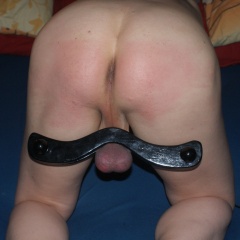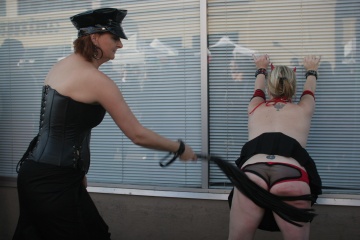 |
Peter Masters |
Peter Masters |
|
|
|||||
| About me | About this site | My books | |||||||
Pain play

Breast torture with heavy-duty clamps
Pain play is any activity which specifically involves the application of, or manipulation of pain, usually to achieve a changed or particular state of mind.
Bondage, for example, is generally not considered to be pain play, while caning, flogging, and whipping are pain play.
Contents
Pain comes in many different "flavours". We can talk about:
- Psychological pain,
- Physical pain,
- Sharp pain,
- Dull pain,
- Discomfort, and
- Extreme discomfort.
Psychological pain

The Humbler prevents a man from standing up, ie. keeps him down on his knees or bending over. See cock and ball torture
Psychological pain can come from activities such as humiliation and interrogation. This sort of pain can come from being pushed into situations which challenge or temporarily destabilise one's sense of personal identity, or from being compelled to maintain a certain psychological, emotional or philosophical stance in the face of extreme pressure. In all cases the effect of the activities can extend from mere discomfort through to intense discomfort or pain (see also below).
Physical pain
Physical pain can come from activities such as flogging, whipping, caning, cutting, paddles and spanking. Perhaps most commonly in BDSM physical pain is associated with impact play, but contenders such as cutting, sometimes piercing, and rough physical handling are also effective sources.
Sharp pain

Caning causes sharp pain
Sharp pain can come from things like as cutting, spanking, whipping, some types of flogging (depending on the flogger being used), piercing with larger gauge needles, branding, and so on.
Sharp pain can be used:
- During training to apply a certain amount of correction combined with motivation to do better next time,
- As a form of punishment for a slave or submissive who hasn't been as attentive to the requirements of his master as he should, or
- To allow a top to control his bottom or submissive. Sharp pain---different to dull pain (see below)---can be used to cause the bottom to flinch, twist, cry, scream, writhe, and so on. These can be excellent responses for a top who desires to be in control and see it.
Dull pain

Some types of flogging create a dull pain instead of a sharp pain
Dull pain is pain that has no exact physical location. Some types of flogger produce this, the sort of pain that arrives as a thud which reverberates through the body, rather than the sort of pain which emanates from a particular point (as in sharp pain). Dull pain usually leaves no particular mark on the skin, as does caning for example. Instead it may only leave a slight reddening of the general area where the pain is being administered.
Dull pain can be used by a submissive or bottom to achieve a changed psychological or mental state. This may be relaxation akin to what you can get through deep body massage, or can be something like subspace. In both these cases it can be helpful if the pain is repeated at short and intervals, such as every couple of seconds, to allow the submissive to get used to it and sink into it.
Discomfort
Some submissives and bottoms have a ready tendency to sink into subspace at the drop of a hat. This can be a good goal in some cases, but the inwards-focussing nature of subspace means that the submissive is not able to engage their partner particularly well (the phrase "dead fish" comes to mind). Where the dominant does want a scene with such a submissive to be a two-way thing they often introduce elements of discomfort to the scene to make sure that their partner doesn't "drift off". This might be an awkward position in bondage, an uncomfortable pinch or an over-tight rope during bondage, or an occasional or intermittent use of a biting or sharp flogger or whip during impact play.
Extreme discomfort
Some BDSM activities such as some forms predicament bondage work by creating a situation where a submissive or bottom may have many different choices of posture or position however none of them is completely comfortable. Indeed, the situations may be contrived by their partner so that each position or posture available to the submissive offers only a brief respite after which discomfort begins to build to the point of being so extreme that the submissive is compelled to change position again. Often this discomfort is caused by muscular fatigue from holding the one position or by unpleasant pressure on parts of the body.
Endurance versus suffering

Suffering versus endurance
It's important to differentiate between suffering pain and enduring pain. They are both different ways of processing the experience of pain and they both have entirely different places in BDSM play.
Suffering pain is about letting the pain into you to create a psychological change or to alter your mental state. It is surrendering to the pain and letting it effect you. It is different from endurance (which we'll see more about below) in that it is about embracing the pain whereas endurance is about resisting it.
Suffering pain is perhaps one of the most frequent ways of achieving subspace. The nature of the pain allows it to be internalised leading to the intense inwards focus characteristic of some forms of subspace. This sort of pain is usually from the more regular and thudding variety of impact play than from sharp or cutting pain.
Enduring pain is about being able to take or resist pain for as long as possible. It is about gritting your teeth and bearing it for as long as possible. There are a number of reasons you might want to do this in your BDSM play:
- You may use pain play---such as caning---as a way of expiating guilt. If this is the case and you have a major load of guilt to deal with, then being able to take a caning as long as possible means that you get rid of more guilt.
- You may see yourself as a bit of a pain slut and try to compete with yourself in terms of how long you can go before you cry "uncle". In each pain play session you make an effort to go just that little bit longer than the time before.
- You might like the chemical high that comes from intense pain and the longer you can take it the higher you get.
- You know your partner likes to hurt you and see you writhing in agony. Being service-oriented you want to be able to take as much as possible so that your partner gets the most out of it as well.
- If you have difficulty surrendering to your partner, or in reaching the point where you can let down your internal barriers and let the pain in so that you can suffer it, then you may need to initially endure pain in a scene until your own desire combines with the intensity of the pain to break down the barriers---at least temporarily---for you.
Increased sensitivity
Some activities increase skin sensitivity and make pain play potentially more interesting. For example:
- Abrasion typically leave the abraded body parts much more sensitive than they were at the outset. This can make the person owning these body parts much more vulnerable and responsive to pain.
- When clamps are removed, particularly from nipples and genitals, the skin remains hyper-sensitive for a short time afterwards. Flicking, slapping, pinching and whipping these areas during this period of increased sensitivity will generally yield very good results.